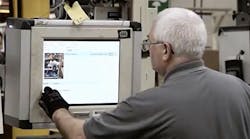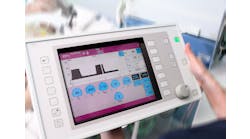The Business Case for Paperless Manufacturing
It’s no secret that the role of paper is rapidly diminishing in our lives, both at home and work. Books, newspapers and magazines are obvious examples, which are quickly being replaced by tablets and e-books. More accurately, the cost of working in a paper-based environment is likely driving more of the change, quickly making paper obsolete.
Today, most companies are aware of the broader paperless evolution—the challenge is how to effectively participate in this change without breaking the bank. In identifying the best approach, solutions and strategy, businesses must effectively balance today’s needs with tomorrow’s evolved performance requirements, and do so on a global scale.
What is Paperless Manufacturing?
True paperless operations solely rely on automated data capture, such as from scanners, touchscreens or automation layer. Information is then displayed on traditional desktop display units, industrial-hardened screens in the plant, large wall-mounted displays, or mobile devices. But it also entails direct connections between systems to avoid additional handling and re-entry of data, which provides seamless continuation of the paperless environment across corporate functions, departments and locations—and out across the supply chain.
A paperless strategy cannot be effectively implemented as an “add-on” to existing applications or systems that were originally designed for a paper-supported environment. You need to have a native-paperless infrastructure and platform.
Any move toward paperless digital operations offers a potential benefit, but the effect is severely limited when the paperless operation is locally optimized. Scanning production data into the system saves time and reduces errors, but the benefits are limited if the worker is scanning from paper shop packets that have to be printed, distributed and controlled.
A truly paperless initiative, in order to be effective and beneficial, should be systematic and comprehensive, based on a platform and infrastructure that natively supports the devices and connections needed for success.The reason why architecture is so important is based on the need for clean, accurate data. Wide and platform-based paperless solutions offer faster response times by the simple fact that data has already been normalized and unified, creating a common infrastructure for consistent decision support and optimized paperless performance.
Lowering Cost of Quality
Everyone wants the highest quality, but the challenge is delivering quality in a cost-effective manner. The market ultimately dictates what an acceptable level of quality is, and what it isn’t. In a competitive industry, the minimum level will steadily increase, so unless your quality is progressively improving, you are actually falling behind.
Interestingly, quality is highly dependent upon accurate and timely information. Not only is pure data important, the timely access to that data is equally critical. If a manufacturer can quickly identify an “out-of-spec” event or shipment, considerable cost savings can be captured by quarantining the materials for further review, discard or return to suppliers. Here is where paperless operations can have a profound impact on the cost of quality. Automated responses, triggered from statistically valid testing, can be done without human involvement, offering a highly effective process for quality management and execution.
A well-designed paperless system should provide quality embedded and enforced at every step of the manufacturing, warehouse or maintenance process, end-to-end across the organization. Direct connection to plant-floor devices supports the archiving, analysis and distribution of production data, parametric measurements and other quality information for process control, improvement and for permanent documentation in support of effective customer service.
Removing Barriers to Innovation
Improving operational productivity has been a hallmark of nearly every manufacturer’s operations strategy for the past century. “Make more with less” are words that have been embraced with vigor and attention. Just as new product introductions are critical to keep a company’s products viable, profits increasing and market leadership ensured, the innovation process leading up to new products is equally important to nurture and embrace.
Obviously, there are many factors that contribute to innovation, ultimately determining which new products will achieve greater market success. The cost of blocked innovation, however, is a more difficult metric to understand. Here the focus is more on how to simplify the “ideation” process that drives innovation. How easily can an idea for a new product be shared and collaboration achieved? What systems and processes are available to help further encourage this type of activity?
Paperless systems offer far greater ease of sharing or collaboration, which is a critical part of most modern supply chains and manufacturing enterprise operations. Collaboration is built on shared information and processes that support multiple user interaction. Your paperless environment provides the data platform and access control while enabling participants to work with the data, coordinate inputs and revisions, share marked-up documents, and maintain a history of activities. This concept applies to collaboration between departments and functions within the organization as well as with partners outside the company and around the world—all potential sources for future innovation.
Automating Adherence to Compliance and Traceability Initiatives
Traceability and provenance are a natural outgrowth of enhanced data collection and management. And because the purpose-built paperless system is designed to include supply chain partners, traceability can extend from farm-to-table or from the mine to the landfill—for the full history of the product and its components and materials. Quality measurements and production data, tied to batch/lot/serial numbers and date/time/location of production, provide a vital link in the chain of traceability. This data is critical in today’s world for food and drugs, of course, but also in many other industries for illicit trade prevention, warranty tracking, supplier and material content documentation, quality improvement work, and product reliability and maintainability improvement.
Information is truly the source of power in a recall situation, critical to limiting the extent of the recall to only those products directly affected by the contamination, flaw or failure. And knowing exactly where every quantity of every batch is located at any given time is the ultimate lever for limiting impact and ensuring fast, total control of the situation. In the absence of detailed records, additional quantities of the product must be recalled to ensure that all potentially affected batches are included.
Creating a Global Paperless Environment
It should be clear by now that a truly complete and effective digital/paperless initiative has the potential to effectively streamline business processes and operational performance. Access to timely, accurate data is now a necessary part of the infrastructure supporting the effective implementation of manufacturing best practices, including the continuous improvement programs that will ensure competitive viability and performance can be maintained today and tomorrow.
Adopting a paperless manufacturing strategy offers the potential to improve operational excellence through higher quality, greater responsiveness to change and less waste. Those manufacturers implementing a paperless strategy on a global scale stand to reap considerably higher returns by linking continuous improvement and collaboration into their paperless solution.
Tadeusz Dyduch is a senior product manager at Apriso, a company that was recently acquired by Dassault Systèmes. In this role, he manages manufacturing and warehouse management applications.




